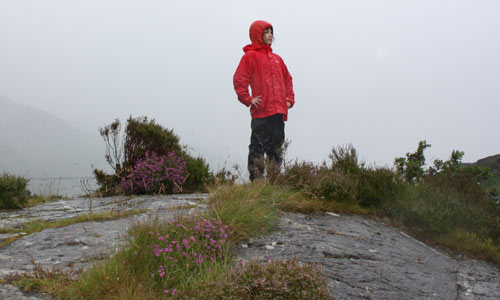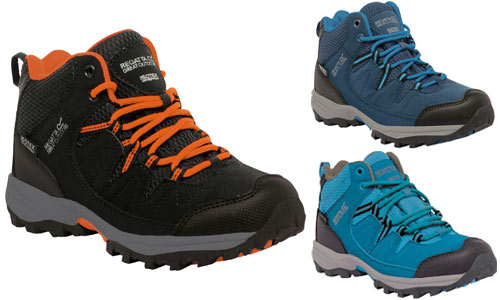Hiking, with kids. Safely (and sanely).
Being a parent or permanent carer for a child isn't always easy. With a number of years of experience I feel that's a fair statement to make. I remember as newly minted parents being caught in a haze of unknowing and new concerns associated with raising another human being; a conversation that featured a very real worry about forgetting to teach them to swim sticks in my mind.
One particular thing that my years of experience have taught me: it's ok to not know everything. It's fine to look things up and just ask someone else for their opinion sometimes. With this in mind, this article is about my experiences of going hiking with kids in a safe and sane manner.

Have a plan
If you go hiking often, develop your strategy for managing your family's individual needs. If you have a baby, toddler or young child, would a backpack carrier for your child help? If so, there's a wide choice available, from unstructured fabric carriers to structured fabric to framed backpack type seats. Talk through the plan with the grown-ups going on the hike. Who's going to be the main carrier, or will the duty be shared? Test and get used to adjusting the straps to fit different grown-ups if it's a shared responsibility before you head out for real.
Know where you're going and your journey time so that you can plan meal breaks and rest stops if needed. Tiny kids often sleep happily in the car but need feeding on a schedule. Small to medium sized kids may need extra stuff to keep them happy on the journey.
'Go bags'
In our household we often have a 'go bag' packed as standard for each child. In the very early days this held nappies, wipes, creams, sunhat and waterproofs. We added food/bottles/comforters/drinks just before we walked out the door with it.
These days the 'go bag' has become a small backpack for each child that holds a waterproof storm jacket, a waterproof pair of leggings, low cut waterproof gaiters, a microfibre towel, a spare pair of trainers, a pair of tracksuit trousers, a t-shirt, a pair of socks, sunhat, suncream, a book, a colouring book and a pencil case. Before we go, a bottle of water and an emergency snack gets added to it. (A grown-up will carry the plasters and the cream to go on bites and stings in their own backpack).
If we leave the house for a hike, however short, each child is expected to have and carry their 'go bag' with them. They aren't heavy. We rarely need these emergency items. Reading my list of contents it sounds like a lot to regularly not need but everything is chosen for its ability to pack down small and light. It makes a good cushion to sit on, doesn't hurt us to carry it, and if we end up needing the contents, we'll be grateful to have them.
Feet!
If there is one statement that I have overused while providing for children in my care, it is "Dear God, the shoes!" Children grow out of shoes like there is no tomorrow. If you don't hike very often it might feel like a bit of a waste to buy walking boots just for the occasion but please do trust me when I say taking kids on a hike in jelly sandals or ballet flats or gym shoes is not an awesome idea. If their feet hurt or they get a blister not only will they know it but so will everyone on the hike, and if you're three kilometres from your car when it happens then the return journey is not going to be fun. Negative experiences with hurting feet are not going to build positive associations with going walking, which is also a shame.
If you absolutely do not want to get walking boots then at the very least put your children in good thick sports socks and regular trainers. I do absolutely recommend children's walking boots, which can be purchased at very reasonable rates, and again at least one pair of good thick sports socks underneath.

If your child will tolerate high ankle boots rather than low cut versions (not all like them at early ages) then these will give a few more inches of protection against nettles, thistles, brambles, and little stones creeping into their footwear.
The weather
We can't control the weather but we can anticipate it, and we can deal with it. Look at the weather forecast for the area where you're hiking before you go. If it's going to be truly bad, consider rescheduling unless you're hardcore hikers and your kids are used to those weather conditions. The Met Office forecasts are the most accurate short range forecasts in the UK.
In the wet weather, try to keep everyone's feet dry. I personally find that wet feet are awful. Walking boots are generally waterproof (yay!) but unless you've splashed out on Sealskins, socks aren't generally waterproof (boo!). As soon as socks get wet at the top, that moisture will start to wick down into the waterproof boots until everything inside the boot is wet too. Did I mention that having wet feet is pretty awful? This is where the low cut gaiters in the 'go bag' come into play. Apply gaiters at the first sign of wet (over the sock but under the trousers) before the rain has a chance to get in, and you have a better chance of keeping those toes dry.
In the hot weather, take plenty of water and sunscreen. Hats and long sleeved loose shirts are the order of the day. In the cold, layer well.
Visibility & proximity
Keep your children in sight on a hike as much as possible. Figure out a safe roaming range based on age and understanding, and teach them to stay within that range. We have a rule: no going around corners unless a grown up signals it's ok.
We have another rule: no hide and seek on hikes, not even on very safe ones on wide safe pathways. It's not worth the anxiety. Buying brightly coloured gear for the little ones will help no end with visibility. Red, orange, yellow and bright blue all stand out well against natural backgrounds and make it easy to spot.
If there's more than one child in the group, make use of the buddy system. Pair them up if possible and get the buddy groups to stay close to each other. If there's more than one adult in the group then consider putting an adult at the front and back of the group on steep slopes, slippery or otherwise unstable footing, crossing water or when doing steps or stiles.
Adapt and teach
Hiking with children is a great experience when you remember that you're hiking with children. Set the pace and the overall journey length to one that is comfortable for their age and ability.
Remember they need refuelling more often than adults might, and may need more rest stops. That old tree or that small stream may be old news to you but children might welcome a few minutes to stop and explore.
Remember they may need toilet breaks even on short hikes where adults might not. Teach them how to wee outdoors safely (not in a nettle patch) and with as much privacy and dignity as they can. There is no polite way of saying this bit so I'm just going to say it: small children will sometimes need a poo at the most inconvenient and unexpected time. There's no point getting cross or upset about this, sometimes it isn't possible or even just comfy to hold it until they get back; so please just read up different methods of dealing with this scenario while on a hike and find a method that works for you.
Teach your kids as you go. Tell them why they have certain things in their 'go bag' to keep them safe if needed. Show them barbed wire and teach them what electric fences look and sound like. Teach them to be quiet around cows and other livestock. We tell the young ones: "Leave the gate as you found it - leave nothing but footprints - take nothing but memories." As they grow, they learn about map reading and staying on the public access paths and all the other more complicated things.
Above all, teach them why you hike. Show them nature - the lightning struck trees, the babbling brooks, the weird looking rock. Make time to peek under logs for mini-beasts and point out the funny shaped clouds. Show them through your own reactions and your own enjoyment why it's good to be out of doors with them. It's nice out there.
Submit a Comment